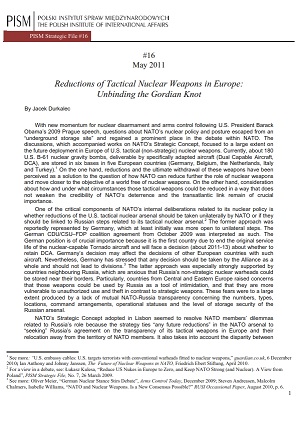№16: Reductions of Tactical Nuclear Weapons in Europe: Unbinding the Gordian Knot
№16: Reductions of Tactical Nuclear Weapons in Europe: Unbinding the Gordian Knot
Author(s): Jacek Durkalec
Subject(s): International Law, Governance, International relations/trade, Security and defense, Military policy
Published by: PISM Polski Instytut Spraw Międzynarodowych
Keywords: nuclear disarmament and arms control; nuclear weapons; nuclear policy; NATO; military policy; security and defence;
Summary/Abstract: With new momentum for nuclear disarmament and arms control following U.S. President Barack Obama’s 2009 Prague speech, questions about NATO’s nuclear policy and posture escaped from an “underground storage site” and regained a prominent place in the debate within NATO. The discussions, which accompanied works on NATO’s Strategic Concept, focused to a large extent on the future deployment in Europe of U.S. tactical (non-strategic) nuclear weapons. Currently, about 180 U.S. B-61 nuclear gravity bombs, deliverable by specifically adapted aircraft (Dual Capable Aircraft, DCA), are stored in six bases in five European countries (Germany, Belgium, the Netherlands, Italy and Turkey). On the one hand, reductions and the ultimate withdrawal of these weapons have been perceived as a solution to the question of how NATO can reduce further the role of nuclear weapons and move closer to the objective of a world free of nuclear weapons. On the other hand, consideration about how and under what circumstances those tactical weapons could be reduced in a way that does not weaken the credibility of NATO’s deterrence and the transatlantic link remain of crucial importance.
Series: PISM Strategic File
- Page Count: 7
- Publication Year: 2011
- Language: English
- Content File-PDF

